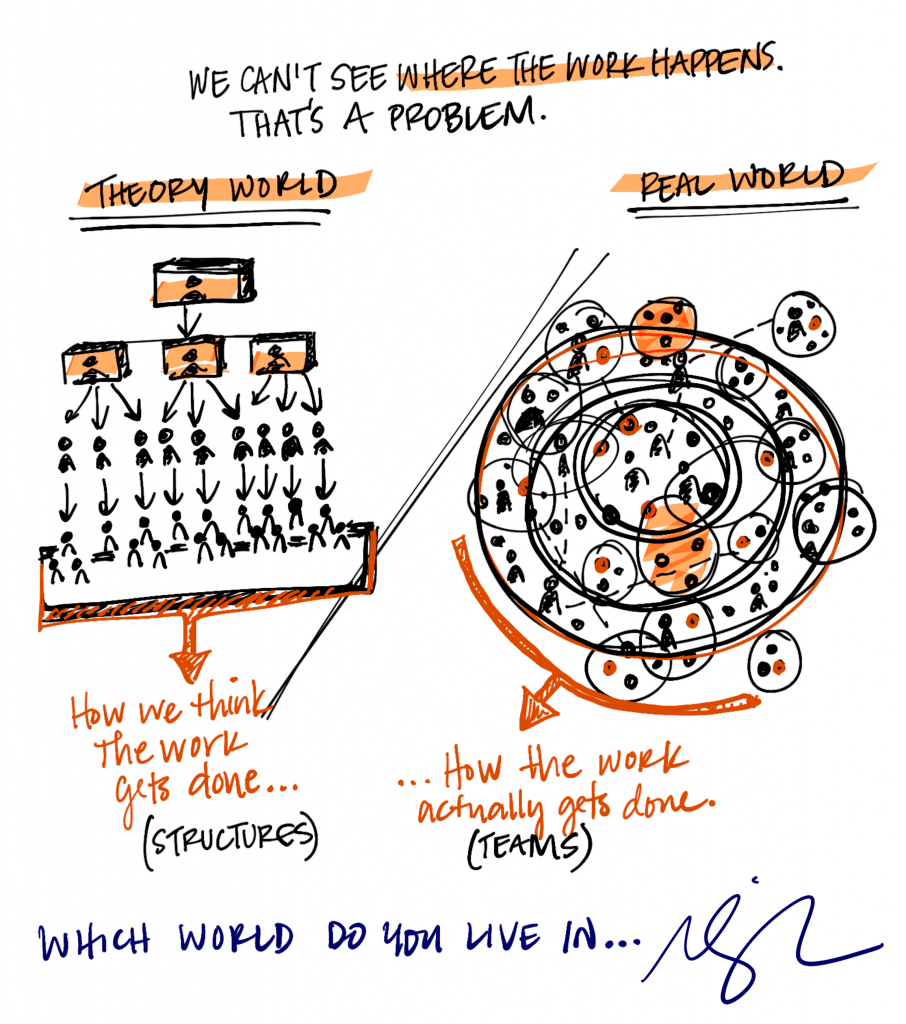We can’t see where the work happens. That’s a problem.
Work happens on teams – the groups that come together for a project, a purpose, or a client. Some of those teams are static and visible on an org chart, but many of them are dynamic and pulled together through different departments, and sometimes different companies.
The problem with HR is that our data structure has rendered us blind to teams. Instead, there are team leaders – sometimes without a manager title – who are pulling people together to get the work done, who are the real source of knowledge for what is working and what isn’t.
But if our org charts and data structure mean we can’t see where the work is actually happening, then almost everything we say about diversity, millennials, engagement, performance, learning, you name it – is all irrelevant. All of those things happen in the context of a small community of people who come together to get work done – a team – and you can’t learn anything about a team if you can’t see it.
HR can’t see these teams, which means we can’t see how the work happens. #LOVEandWORK Share on XHR can’t see these teams, which means we can’t see how the work happens. If we can’t see how the work happens, that means we can’t affect the work – and that’s a problem.
7 Comments
Comments are closed.


Great observation, Marcus. This also means we cannot see the real leaders. And I suspect it also means that a large part of the management and leadership training does not equip leaders to lead in this environment, where they have no formal authority.
Loved the video Marcus…and thank you for taking a stand to articulate a new way of working that flies in the face of conventional wisdom. Because we both know the org chart is not your friend.
I’ve struggled, in my one-man consulting firm, to sell the work that I’m passionate about and love to do. To work with my client to identify the informal network within their matrix organization…work hard to engage these key stakeholders…and then create environments (i.e facilitated sessions) where the informal network can organically align around the best solution, the strongest implementation plan, or other deliverables the project requires. I’ve also observed that when you’ve invited the stakeholders (that make up your informal network) in from the beginning, their fingerprints are all over the solution, implementation plan, etc. and now you have 8 or 80 people that have a shared sense of ownership…in my client’s project. My client has just given themselves their best shot at flawless execution. I call this way of working ‘Alliancing’.
I typically have to sell prospects on ‘what’ I’ve done in the past (digital strategy, channel marketing, B2B marketing), but in terms of the aspirational project outcomes we achieve together…they’re really paying for the ‘how’ I work with teams and informal networks.
Any guidance you could offer on my biz dev dilemma?
To build on Ashton’s comments, we can’t evaluate performance unless the team get’s to participate, nor can we hire people who fit if the team isn’t part of the new hire interviews and on-boarding. The first step in being effective is to organize your department into client facing teams/individuals as part of the department team. if you stick with the arrangement you’ll notice more collaboration, less resistance to achieving your objectives and an empowered department team.
Why do there have to be leaders of every team? I use a system where every person takes turns in their leadership role depending on their strengths and when they should be called upon.
Hi Pamela,
That’s an interesting concept. How does that work? How often does the Team Leader change and how big are the teams?
Cheers,
What a great concept!
Brilliant!!